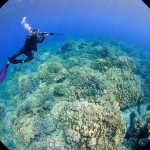By guest writer Elizabeth Weinberg, social media coordinator and editor/writer, Office of National Marine Sanctuaries National Oceanic and Atmospheric Administration
For more than 40 years, national marine sanctuaries have worked to protect special places in America’s ocean and Great Lakes waters, from the Hawaiian Islands to the Florida Keys, from Lake Huron to American Samoa. Backed by one of the nation’s strongest pieces of ocean conservation legislation, the National Marine Sanctuaries Act, the sanctuaries seek to preserve the extraordinary beauty, biodiversity, historical connections and economic productivity of our most precious underwater treasures. And — lucky for you — most of these places are accessible to recreational divers. Sanctuary waters are filled with unique ecosystems, harboring a spectacular array of plants, animals and historical artifacts, all waiting to be explored. We’ll begin our series on national marine sanctuaries with the Hawaiian Islands Humpback Whale National Marine Sanctuary. These places belong to everyone, so dive in.
Hawaiian Islands Humpback Whale National Marine Sanctuary
Since at least the 1840s, North Pacific humpback whales have wintered in the warm, shallow waters surrounding the Hawaiian Islands. Though the humpback whale population was depleted by commercial whaling at the start of the 20th century, an international ban on commercial whaling and protections under the Endangered Species Act and the Marine Mammal Protection Act have enabled the species to bounce back. Some 10,000 whales now return to Hawaii each year to mate, calve and nurse their young. These waters constitute one of the world’s most important North Pacific humpback whale habitats, and the only place in U.S. coastal waters where humpbacks reproduce. Hawaiian Islands Humpback Whale National Marine Sanctuary was established in 1992 to protect these endangered species and their habitat.
Humpbacks whales aren’t the only charismatic animal residents of the sanctuary; divers may also encounter Hawaiian monk seals, spinner dolphins, manta rays and sea turtles swimming through this warm water. Dive down to one of the sanctuary’s many coral reefs to see sponges, sea anemones, and corals up close, and to spot many of Hawai’i’s 700 species of reef fish, including the official state fish, the humuhumunukunukuapua’a, or Picasso triggerfish.
If you need a break from diving or have a dry day and want to help the sanctuary keep tabs on the humpback whale population, join the Sanctuary Ocean Count project and help monitor humpback whales from the shores of O’ahu, Hawai’i and Kaua’i. Check out the wonders of Hawaiian Islands Humpback Whale National Marine Sanctuary via our photos, and see more here.
*Cover image credit: Ed Lyman/NOAA Permit #774-1714
The post Exploring National Marine Sanctuaries: Hawaiian Islands Humpback Whale appeared first on Scuba Diver Life.









